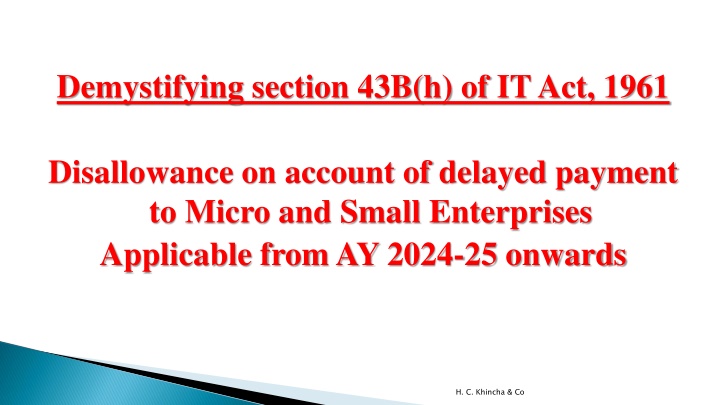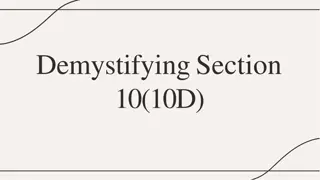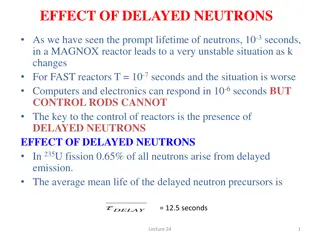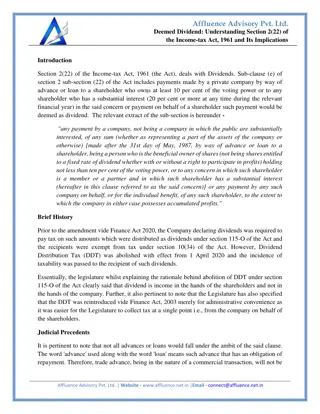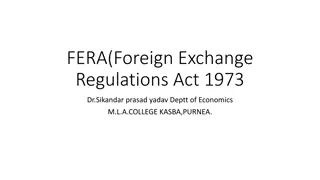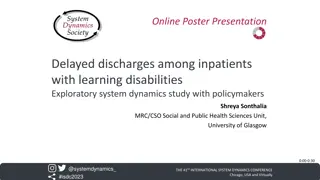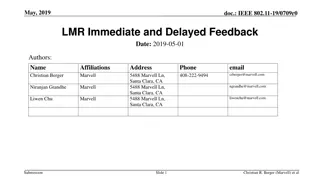Demystifying Section 43B(h) of IT Act, 1961: Disallowance on Delayed Payments
Section 43B(h) of the Income Tax Act, 1961 pertains to disallowances for delayed payments to Micro and Small Enterprises, applicable from AY 2024-25 onwards. MSMEs, or Micro, Small, and Medium Enterprises, are vital to the Indian economy, contributing significantly to GDP, manufacturing output, and exports. The section mandates deductions based on actual payment rather than accrual basis, with provisions for timely payment support to MSMEs for promoting socio-economic welfare.
Download Presentation

Please find below an Image/Link to download the presentation.
The content on the website is provided AS IS for your information and personal use only. It may not be sold, licensed, or shared on other websites without obtaining consent from the author.If you encounter any issues during the download, it is possible that the publisher has removed the file from their server.
You are allowed to download the files provided on this website for personal or commercial use, subject to the condition that they are used lawfully. All files are the property of their respective owners.
The content on the website is provided AS IS for your information and personal use only. It may not be sold, licensed, or shared on other websites without obtaining consent from the author.
E N D
Presentation Transcript
Demystifying section 43B(h) of IT Act, 1961 Disallowance on account of delayed payment to Micro and Small Enterprises Applicable from AY 2024-25 onwards H. C. Khincha & Co
Presentation by : CA. Naveen Khariwal Chartered Accountant Partner : H.C. Khincha & Co H.C. Khincha & Associates No. 40, 1ST Floor, Laxmi Complex, K R Fort Road, Bangalore - 560 002. naveenkhariwalg@gmail.com Mob No : 9880683725 H. C. Khincha & Co
What is MSMEs? MSMEs are Micro, Small and Medium Enterprises engaged is manufacturing and supply of more than 6000 products. Generally, the number of 6000 products includes necessity consumer products such as Milk, Biscuits, packed foods etc. MSMEs play a significant role in the Indian economy, MSMEs immensely contribute almost 8% of the nation s GDP, around 45% of manufacturing output and 40% of exports. MSMEs are also termed as Backbone of the nation. Government provide support to MSMEs by granting them Collateral free guarantee under Credit Guarantee Scheme for Micro, Small and Medium Enterprises. Support by Indian Government helps MSMEs to expand more, expansion leads to growth and growth will automatically increase employment opportunities in the nation. H. C. Khincha & Co
What is section 43B of Income Tax Act, 1961? Section 43B of the Income Tax Act, 1961 has specified certain deductions which shall be allowed as deduction under the head Income from business and profession on actual payment basis rather than accrual basis. Hence, section 43B advocates deduction of spending on an actual payment basis. However, this section shall not apply if payment is made by an assessee on or before due date of filing the return under section 139(1) in respect of the previous year in which liability was incurred. H. C. Khincha & Co
MSMEs and Professionals 134. MSMEs are growth engines of our economy. . Moreover, to support MSMEs in timely receipt of payments, I propose to allow deduction for expenditure incurred on payments made to them only when payment is actually made. H. C. Khincha & Co
B. Socio Economic Welfare Measures Promoting timely payments to Micro and Small Enterprises Section 43B of the Act provides for certain deductions to be allowed only on actual payment. Further, the proviso of this section allows deduction on accrual basis, if the amount is paid by due date of furnishing of the return of income. H. C. Khincha & Co
2. In order to promote timely payments to micro and small enterprises, it is proposed to include payments made to such enterprises within the ambit of section 43B of the Act. Accordingly, it is proposed to insert a new clause (h) in section 43B of the Act to provide that any sum payable by the assessee to a micro or small enterprise beyond the time limit specified in section 15 of the Micro, Small and Medium Enterprises Development (MSMED) Act 2006 shall be allowed as deduction only on actual payment. However, it is also proposed that the proviso to section 43B of the Act shall not apply to such payments. H. C. Khincha & Co
3. Section 15 of the MSMED Act mandates payments to micro and small enterprises within the time as per the written agreement, which cannot be more than 45 days. If there is no such written agreement, the section mandates that the payment shall be made within 15 days. Thus, the proposed amendment to section 43B of the Act will allow the payment as deduction only on payment basis. It can be allowed on accrual basis only if the payment is within the time mandated under section 15 of the MSMED Act. 4. This amendment will take effect from 1st April, 2024 and will accordingly apply to the assessment year 2024-25 and subsequent assessment years. [clause 13] H. C. Khincha & Co
Amendment in Section 43B As per the Amendment made by the Finance Act, 2023 clause (h) shall be inserted after clause (g) of section 43B. Clause (h) reads as under: 43B. Notwithstanding anything contained in any other provision of this Act, a deduction otherwise allowable under this Act in respect of - (a) (b) (c) (d) (e) (f) (g) H. C. Khincha & Co
Section 43B(h) any sum payable by the assessee to a micro or small enterprise beyond the time limit specified in section 15 of the Micro, Small and Medium Enterprises Development Act, 2006 (27 of 2006), shall be allowed only (irrespective of the previous year in which the liability to pay such sum was incurred by the assessee according to the method of accounting regularly employed by him) in computing the income referred to in section 28 of that previous year in which such sum is actually paid by him H. C. Khincha & Co
Provided that nothing contained in this section except the provisions of clause(h) shall apply in relation to any sum which is actually paid by the assessee on or before the due date applicable in his case for furnishing the return of income under sub-section (1) of section 139 in respect of the previous year in which the liability to pay such sum was incurred as aforesaid and the evidence of such payment is furnished by the assessee along with such return. H. C. Khincha & Co
Further, clause (e) & (g) of explanation 4 to section 43B is also inserted which defines micro enterprise and small enterprise respectively and the same are as under: 43B(e) micro enterprise shall have the meaning assigned to it in clause (h) of section 2 of the Micro, Small and Medium Enterprises Development Act, 2006 (27 of 2006). 43B(g) small enterprise shall have the meaning assigned to it in clause (m) of section 2 of the Micro, Small and Medium Enterprises Development Act, 2006 (27 of 2006). H. C. Khincha & Co
CBDT Circular 1/2024, dt. Dated the 23rd of January, 2024 explains that: 21. Promoting timely payments to Micro and Small Enterprises (is the object). 21.1 Section 43B of the Act provides for certain deductions to be allowed only on actual payment. Further, the proviso of this section allows deduction on accrual basis, if the amount is paid by due date of furnishing of the return of income. 21.2 In order to promote timely payments to micro and small enterprises, payments made to such enterprises have been included within the ambit of section 43B of the Act vide FA 2023. A new clause (h) has been inserted in section 43B of the Act to provide that any sum payable by the assessee to a micro or small enterprise beyond the time limit specified in section 15 of the Micro, Small and Medium Enterprises Development (MSMED) Act 2006 shall be allowed as deduction only on actual payment. However, it has also been provided that the proviso to section 43B of the Act shall not apply to such payments. H. C. Khincha & Co
21.3 Section 15 of the MSMED Act mandates payments to micro and small enterprises within the time as per the written agreement, which cannot be more than 45 days. If there is no such written agreement, the section mandates that the payment shall be made within 15 days. Thus, this amendment to section 43B of the Act allows the payment as deduction only on payment basis. It can be allowed on accrual basis only if the payment is within the time mandated under section 15 of the MSMED Act. Applicability: This amendment takes effect from 1st April, 2024 and will accordingly apply in relation to the assessment year 2024-25 and subsequent assessment years. H. C. Khincha & Co
RELEVANT PROVISIONS OF MICRO, SMALL AND MEDIUM ENTERPRISES DEVELOPMENT ACT, 2006 (MSMED ACT 2006) H. C. Khincha & Co
Section 15 of MSMED Act, 2006 Liability of buyer to make payment. Where any supplier, supplies any goods or gives any services to any buyer, the buyer shall make payment therefor on or before the date agreed upon between him and the supplier in writing or, where there is no agreement in this behalf, before the appointed day: Provided that in no case the period agreed upon between the supplier and the buyer in writing shall exceed forty-five days from the day of acceptance or the day of deemed acceptance. H. C. Khincha & Co
Section 16 of MSMED Act, 2006 Date from which and rate at which interest is payable. Where any buyer fails to make payment of the amount to the supplier, as required under section 15, the buyer shall, notwithstanding anything contained in any agreement between the buyer and the supplier or in any law for the time being in force, be liable to pay compound interest with monthly rests to the supplier on that amount from the appointed day or, as the case may be, from the date immediately following the date agreed upon, at three times of the bank rate notified by the Reserve Bank. H. C. Khincha & Co
Section 23 of MSMED Act, 2006 Interest not to be allowed as deduction from income. 23. Notwithstanding anything contained in the Income-tax Act, 1961 (43 of 1961), the amount of interest payable or paid by any buyer, under or in accordance with the provisions of this Act, shall not, for the purposes of computation of income under the Income-tax Act, 1961, be allowed as deduction. H. C. Khincha & Co
Section 7 of MSMED Act, 2006 Sub-section (1) of Section 7 of the MSMED Act provides that the Central Government may, for the purposes of this Act, by notification (in the Official Gazette), classify any class or classes of manufacturing or service enterprises, whether proprietorship, HUF, association of persons, co-operative society, partnership firm, company or undertaking, by whatever name called, into: Micro Enterprises Small Enterprises Medium Enterprises a. b. c. H. C. Khincha & Co
Sub-section (9) of Section 7 of the MSMED Act provides that the Central Government may, while classifying any class or classes of enterprises under sub-section (1), vary, from time to time, the criterion of investment and also consider criteria or standards in respect of employment or turnover of the enterprises and include in such classification the micro or tiny enterprises or the village enterprises, as part of small enterprises. The Central Government has issued Notification No. 2119(E), dated 26-6-2020, under Section 7(1) read with Section 7(9) of the MSMED Act. Para 3(1) of the said Notification provides that a composite criterion of investment and turnover shall apply for the classification of an enterprise as micro, small or medium. H. C. Khincha & Co
Para 1 provides that an enterprise shall be classified as a micro, small or medium enterprise on the basis of the following criteria: H. C. Khincha & Co
It must be noted that only micro and small enterprises are considered suppliers for the purpose of Section 43B(h). Medium enterprises are not regarded as suppliers and are not entitled to enforce prompt payment and interest for delayed payment. H. C. Khincha & Co
Section 2(b) defines appointed day as under: appointed day means the day following immediately after the expiry of the period of fifteen days from the day of acceptance or the day of deemed acceptance of any goods or any services by a buyer from a supplier. Explanation - For the purposes of this clause, - (i) the day of acceptance means, - (a) the day of the actual delivery of goods or the rendering of services; or (b) where any objection is made in writing by the buyer regarding acceptance of goods or services within fifteen days from the day of the delivery of goods or the rendering of services, the day on which such objection is removed by the supplier. H. C. Khincha & Co
(ii) the day of deemed acceptance means, where no objection is made in writing by the buyer regarding acceptance of goods or services within fifteen days from the day of the delivery of goods or the rendering of services, the day of the actual delivery of goods or the rendering of services; H. C. Khincha & Co
Sec. 2(d) defines buyer as follows: Buyer means whoever buys any goods or receives any services from a supplier for consideration. Section 2(h) defines micro enterprise as follows : "micro enterprise" means an enterprise classified as such under sub-clause (i) of clause (a) or sub-clause (i) of clause (b) of sub-section (1) of section 7; Section 2(m) defines small enterprise as follows : "small enterprise" means an enterprise classified as such under sub-clause (ii) of clause (a) or sub-clause (ii) of clause (b) of sub-section (1) of section 7; H. C. Khincha & Co
Section 2(n) defines supplier as under: Supplier means a micro or small enterprise, which has filed a memorandum with the authority referred to in sub-section (1) of section 8, and includes - (i) the National Small Industries Corporation, being a company, registered under the Companies Act, 1956 (1 of 1956); (ii) the Small Industries Development Corporation of a State or a Union territory, by whatever name called, being a company registered under the Companies Act, 1956 (1 of 1956); (iii) any company, co-operative society, trust or a body, by whatever name called, registered or constituted under any law for the time being in force and engaged in selling goods produced by micro or small enterprises and rendering services which are provided by such enterprises. H. C. Khincha & Co
Section 2(e) defines the term "enterprise" as under: "Enterprise means an industrial undertaking or a business concern or any other establishment, by whatever name called, engaged in the manufacture or production of goods, in any manner, pertaining to any industry specified in the First Schedule to the Industries (Development and Regulation) Act, 1951 or engaged in providing or rendering any service or services". H. C. Khincha & Co
i. The enterprise must be engaged in the manufacture or production of goods / rendering any services. ii. Therefore, an enterprise which is engaged in trading is not covered by the term "enterprise". iii. Expression "engaged" is not defined in the MSME Act, 2006. iv. However, in the portal www.dcmsme.gov.in being the portal belonging to the Government of India the meaning of manufacturing enterprise is explained as "employing plant and machinery in the process of value addition to the final product having a distinct name or character or use". Thus, a unit engaged in manufacturing or producing an article which is having distinct name or character or use can be stated as an entity covered by the definition. H. C. Khincha & Co
v. In National Projects Construction Corpn. Ltd. v. CWT [1969] 74 ITR 465 (Delhi) the court was to decide about an industrial undertaking engaged in the manufacture or production or processing of goods or articles. It held that "the word 'engage' may have variety of meanings depending on the context and setting in which it is used. Ordinarily the expression connotes doing of more than one act or one transaction. Continuity of action is implicit in the meaning of the word. It has also been used in the sense of being busy or conducting or devoting attention or effort or employing oneself. The words "engaged in the manufacture, production" etc should normally, therefore mean continuously occupied in the manufacture as a principal business as distinguished from occasional participation or single act or casual employment or a mere supervision without physical participation. The extent of activity would be a relevant factor and if such activity is at an extended scale, it may be suggestive of being "engaged" in manufacturing activity." H. C. Khincha & Co
vi. Another limb of the definition is "manufacture or production of goods, in any manner, pertaining to any industry specified in the First Schedule to the Industries (Development and Regulation) Act, 1951". H. C. Khincha & Co
The following goods whether manufactured or produced in any manner is covered: THE FIRST SCHEDULE [See sections 2 and 3(i)] Any industry engaged in the manufacture or production of any of the articles mentioned under each of the following heading or sub-headings, namely:- 1. METALLURGICAL INDUSTRIES: A. Ferrous : (1)Iron and steel (metal). (2) Ferro- alloys. (3) Iron and steel castings and forgings. (4) Iron and steel structurals. (5) Iron and steel pipes. (6) Special steels. (7) Other products of iron and steel. H. C. Khincha & Co
(8) Iron and steel (metal). (9) Ferro- alloys. (10) Iron and steel castings and forgings. (11) Iron and steel structurals. (12) Iron and steel pipes. (13) Special steels. (14) Other products of iron and steel. B. Non-ferrous: (1)Precious metals, including gold and silver, and their alloys. (1A) Other non-ferrous metals and their alloys.] (2) Semi-manufactures and manufactures. FUELS; (1)Coal, lignite, coke and their derivatives. (2) Mineral oil (crude oil), motor and aviation spirit, diesel oil, kerosene oil, fuel oil, diverse hydrocarbon oils and their blends including synthetic fuels, lubricating oils and the like. (3) Fuel gases-(coal gas, natural gas and the like). 2. H. C. Khincha & Co
BOILERS AND STEAM GENERATING PLANTS: (1) Boilers and steam generating plants. PRIME MOVERS (OTHER THAN ELECTRICAL GENERATORS) : (1)Steam engines and turbines. (2) Internal combustion engines. ELECTRICAL EQUIPMENT: (1)Equipment for generation, transmission and distribution of electricity including transformers. (2) Electrical motors. (3) Electrical fans. (4) Electrical lamps. (5) Electrical furnaces. (6) Electrical cables and wires. (7) X-ray equipment. (8) Electronic equipment (9) Household appliances such as electric irons, heaters and the like. (10) Storage batteries. (11) Dry cells. 3. 4. 5. H. C. Khincha & Co
TELECOMMUNICATIONS: (1)Telephones. (2) Telegraph equipment. (3) Wireless communication apparatus. (4) Radio receivers, including amplifying and public address equipment. (5) Television sets. (6) Teleprinters TRANSPORTATION: (1)Aircraft. (2) Ships and other vessels drawn by power. (3) Railway locomotives. (4) Railway rolling stock. (5) Automobiles (motor cars, buses, trucks, motor cycles, scooters and the like). (6) Bicycles. (7) Others such as fork lift trucks and the like. 6. 7. H. C. Khincha & Co
8 INDUSTRIAL MACHINERY: A. Major items of specialised equipment used in specific industries: (1)Textile machinery (such as spinning frames, carding machines powerlooms and the like) including textile accessories. (2) Jute machinery. (3) Rayon machinery. (4) Sugar machinery. (5) Tea machinery. (6) Mining machinery. (7) Metallurgical machinery. (8) Cement machinery. (9) Chemical machinery. (10) Pharmaceuticals machinery. (11) Paper machinery. H. C. Khincha & Co
B. General items of machinery used in several industries, such as the equipment required for various "unit processes": (1)Size reduction equipment - crushers, ball mills and the like. (2) Conveying equipment- bucket elevators, skip hoist, cranes, derrick and the like. (3) Size separation units-screens, classifiers and the like. (4) Mixers and reactors-kneading mills, turbo mixers and the like. (5) Filtration equipment-filter presses, rotary filters and the like. (6) Centrifugal machines. (7) Evaporators. (8) Distillation equipment. (9) Crystallisers. (10) Driers. (11) Power driven pumps-reciprocating, centrifugal and the like. (12) Air and gas compressors and vacuum pipes (excluding electrical furnaces). (13) Refrigeration plants for industrial use. (14) Firefighting equipment and appliances including fire engines. H. C. Khincha & Co
C. Other items of industrial Machinery: (1)Ball, roller and tapered bearings. (2) Speed reduction units. (3) Grinding wheels and abrasives. MACHINE TOOLS: (1) Machine Tools. AGRICULTURAL MACHINERY: (1)Tractors, harvestors and the like. (2) Agricultural implements. EARTH-MOVING MACHINERY: Bulldozers, dumpers, scrapers, loaders, shovels, drag lines, bucket wheel excavators, road rollers and the like. 9 10 11 H. C. Khincha & Co
MISCELLANEOUS MECHANICAL AND ENGINEERING INDUSTRIES: 12 (1)Plastic moulded goods. (2) Hand tools, small tools and the like. (3) Razor blades. (4) Pressure Cookers. (5) Cutlery. (6) Steel furniture. COMMERCIAL, OFFICE AND HOUSEHOLD EQUIPMENT: (1)Typewriters. (2) Calculating machines. (3) Air conditioners and refrigerators. (4) Vacuum cleaners. (5) Sewing and knitting machines. (6) Hurricane lanterns. MEDICAL AND SURGICAL APPLIANCES: (1) Surgical instruments- sterilisers, incubators and the like. 13 14 H. C. Khincha & Co
INDUSTRIAL INSTRUMENTS. (1)Water metres, steam metres, electricity metres and the like. (2)Indicating, recording and regulating devices for pressure, temperature, rate of flow, weights, levels and the like. (3)Weighing machines. SCIENTIFIC INSTRUMENTS: (1) Scientific instruments. MATHEMATICAL, SURVEYING AND DRAWING INSTRUMENTS: (1) Mathematical, surveying and drawing instruments. FERTILISERS: (1)Inorganic fertilizers. (2) Organic fertilisers. (3) Mixed fertilisers. 15 16 17 18 H. C. Khincha & Co
CHEMICAL (OTHER THAN FERTILISERS): (1)Inorganic heavy chemicals. (2) Organic heavy chemicals. (3) Fine chemicals including photographic chemicals. (4) Synthetic resins and plastics. (5) Paints, varnishes and enamels. (6) Synthetic rubbers. (7) Man-made fibres including regenerated cellulose rayon, nylon and the like. (8) Coke oven by-products. (9) Coal tar distillation products like naphthalene, anthracene and the like. (10) Explosives including gun powder and safety fuses. (11) Insecticides, fungicides, weedicides and the like. (12) Textile auxiliaries. (13) Sizing materials including starch. (14) Miscellaneous chemicals. 19 H. C. Khincha & Co
PHOTOGRAPHIC RAW FILM AND PAPER: (1)Cinema film. (2) Photographic amateur film. (3) Photographic printing paper DYE-STUFFS: Dye-stuffs. DRUGS AND PHARMACEUTICALS: Drugs and Pharmaceuticals. TEXTILES (INCLUDING THOSE DYED, PRINTED OR OTHERWISE PROCESSED): (1) Made wholly or in part of cotton, including cotton yarn, hosiery and rope. (2) Made wholly or in part of jute, including jute twine and rope. (3) Made wholly or in part of wool, including wool tops, woolen yarn, hosiery, carpets and druggets; (4) Made wholly or in part of silk, including silk yarn and hosiery; (5) Made wholly or in part of synthetic, artificial (man-made) fibres, including yarn and hosiery of such fibres. PAPER AND PULP INCLUDING PAPER PRODUCTS: (1) Paper - writing, printing and wrapping. (2) Newsprint. (3) Paper board and straw board. (4) Paper for packaging (corrugated paper, kraft paper, bags, paper containers and the like). (5) Pulp - wood pulp, mechanical, chemical, including dissolving pulp. 20 21 22 23 24 H. C. Khincha & Co
SUGAR : (1) Sugar FERMENTATION INDUSTRIES: (1)Alcohol. (2) Other products of fermentation industries. FOOD PROCESSING INDUSTRIES: (1)Canned fruits and fruit products. (2) Milk foods. (3) Malted Foods. (4) Flour. (5) Other processed foods. VEGETABLE OILS AND VANASPATHI: (1)Vegetable oils, including solvent extracted oils. (2) Vanaspati. 25 26 27 28 H. C. Khincha & Co
SOAPS, COSMETICS AND TOILET PREPARATIONS: (1)Soaps (2) Glycerine (3) Cosmetics (4) Perfumery (5) Toilet preparations RUBBER GOODS: (1) Tyres and tubes. (2) Surgical and medical products including prophylactics. (3) Footwear. (4) Other rubber goods. LEATHER, LEATHER GOODS AND PICKERS: (1) Leather, leather goods and pickers. GLUE AND GELATIN (1) Glue and gelatin. 29 30 31 32 H. C. Khincha & Co
GLASS: (1) Hollow ware. (2) Sheet and plate glass. (3) Optical glass. (4) Glass wool. (5) Laboratory ware. (6) Miscellaneous ware. CERAMICS: (1) Fire bricks. (2) Refractories. (3) Furnace lining bricks - acidic, basic and neutral. (4) China ware and pottery. (5) Sanitary ware. (6) Insulators. (7) Tiles. (8) Graphite Crucibles. 33 34 H. C. Khincha & Co
CEMENT AND GYPSUM PRODUCTS: (1)Portland cement. (2) Asbestos cement. (3) Insulating boards. (4) Gypsum boards, wall boards and the like. 35 TIMBER PRODUCTS: (1) Plywood. (2) Hardboard, including fibre-board, chip-board and the like. (3) Matches. (4) Miscellaneous (furniture components, bobbins, shutters and the like) DEFENCE INDUSTRIES: (1) Arms and ammunition. MISCELLANEOUS INDUSTRIES: (1) Cigarettes. (2) Linoleums, whether felt based or jute based. (3) Zip fasteners (metallic and non-metallic). (4) Oil Stoves. (5) Printing, including litho printing industry. 36 37 38 H. C. Khincha & Co
Explanation 1 - The articles specified under each of the headings Nos. 3, 4, 5, 6,7, 8, 10, 11 and 13 shall include their component parts and accessories. Explanation 2 - The articles specified under each of the headings Nos. 18, 19, 21 and 22 shall include the intermediates required for their manufacture. H. C. Khincha & Co
vii. Enterprises covered & other conditions Units who are engaged in manufacture or production of goods listed in First Schedule to Industries (Regulation and Development) Act, 1951 are classified as under as per Notification No. S.O. 2119 (E) dated 26th June, 2020: Micro enterprise Small enterprise Medium enterprise Investment in Plant & Machinery or equipment Does not exceed Rs. 1 crore And Does not exceed Rs.5 crore Does not exceed Rs.10 crore And Does not exceed Rs.50 crore Does not exceed Rs.50 crore And Does not exceed Rs.250 crore Turnover H. C. Khincha & Co
viii. In the same notification it is stated that that composite criteria of investment and turnover would be applied for classification as micro, small and medium enterprise. Which means both the conditions given in the above table are to be satisfied for classifying a unit as micro, small or medium enterprise. ix. It is also stated that if an enterprise crosses any of the limits specified in its present category either by way of investment in plant & machinery / equipment or turnover, it would be placed in the next higher category. However, for downgrading the enterprise, both the criteria should be below the limit from the existing level. H. C. Khincha & Co
x. As regards, calculation of investment in plant & machinery or equipment, it is with reference to the ITR of the previous year filed under the Income tax Act,1961. Therefore, WDV of the assets would be considered and not their original cost. xi. Similarly, for computing the turnover, it shall exclude export of goods or services or both. Information as regards turnover and export turnover shall be linked to the Income-tax Act, 1961 or the Central Goods and Services Act and the GSTIN. H. C. Khincha & Co
